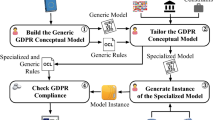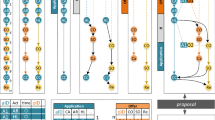Abstract
We present an efficient base algorithm for binding-time analysis based on constraint solving and the union-find algorithm. In practice it has been used to handle all of Standard ML except modules and we show the principles of how constraints can be used for binding-time analysis of Standard ML; in particular we show how to binding-time analyse nested pattern matching. To the best of our knowledge no previous binding-time analysis has treated nested pattern matching.
Similar content being viewed by others
References
Lars Ole Andersen. C program specialization. Technical Report 92/14, DIKU, Department of Computer Science, University of Copenhagen, May 1992.
Lars Ole Andersen. Binding time analysis and the taming of C pointers. InProceedings of the ACM SIGPLAN Symposium on Partial Evaluation and Semantics-Based Program Manipulation, pages 47–58. ACM Press, June 1993.
Lars Birkedal and Morten Welinder. Partial evaluation of Standard ML. Technical Report 93/22, DIKU, October 1993.
Anders Bondorf and Jesper Jørgensen. Efficient analyses for realistic off-line partial evaluation.Journal of Functional Programming, 3(3):315–346, 1993.
Kei Davis. Pers from projections for binding-time analysis.Lisp and Symbolic Computation, (this volume), 1995. Special issue on Partial Evaluation and Semantics-Based Program Manipulation.
Anne de Niel.Self-Applicable Partial Evaluation of Polymorphically Typed Functional Languages. PhD thesis, Katholieke Universiteit Leuven, January 1993.
Fritz Henglein. Efficient type inference for higher-order binding-time analysis. In J. Hughes, editor,Functional Programming Languages and Computer Architecture, LNCS 523, pages 448–472. Springer-Verlag, 1991.
Neil D. Jones, Carsten K. Gomard, and Peter Sestoft.Partial Evaluation and Automatic Program Generation. Prentice-Hall, 1993.
John Launchbury.Projection Factorisations in Partial Evaluation. Cambridge University Press, 1991.
Robin Milner, Mads Tofte, and Robert Harper.The Definition of Standard ML. MIT Press, 1990.
Jens Palsberg and Michael I. Schwartzbach. Binding-time analysis: Abstract interpretation versus type inference. InProc. ICCL'94, Fifth IEEE International Conference on Computer Languages, Toulouse, France, May 1994.
Author information
Authors and Affiliations
Additional information
The present work was conducted while the author was at DIKU.
Rights and permissions
About this article
Cite this article
Birkedal, L., Welinder, M. Binding-time analysis for Standard ML. Lisp and Symbolic Computation 8, 191–208 (1995). https://doi.org/10.1007/BF01019003
Issue Date:
DOI: https://doi.org/10.1007/BF01019003




